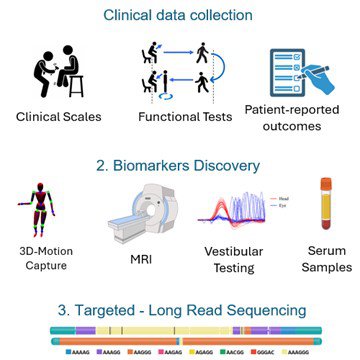
2025 Post-doctoral Clinical Fellowship
Combining clinical, biological, and digital outcomes to track disease progression in Cerebellar ataxia, neuropathy, and vestibular areflexia syndrome (CANVAS)
Cerebellar Ataxia, Neuropathy, and Vestibular Areflexia Syndrome (CANVAS) is a neurological condition that affects the three main systems in the body that help with balance: the cerebellum, the nerves that collect information about the position of the body in the space (proprioception), and the inner ear. People with CANVAS have trouble keeping their balance and often feel numbness in their body. In some cases, this disease also affects speaking and swallowing, making daily life even more difficult.
Our group discovered that CANVAS has a genetic cause – it happens when a tiny piece of genetic code (AAGGG) gets repeated too many times in a gene called RFC1. We also found that it is a rather common condition in ageing population and is often undiagnosed. Even though we are learning more about how the brain and nerves get damaged in CANVAS, we do not yet have good ways to track how quickly the condition gets worse in patients over time.
This research project aims to solve this problem by collecting different types of information from CANVAS patients, including medical check-ups, scans of the brain and of the spinal cord, blood tests, and advanced, computer-based analysis of walking.
I will also use innovative techniques to look in detail at the DNA sequence of these patients to investigate the presence of interruptions across the repeated AAGGG units, as these interruptions can modify the disease severity.
My work will help to find the best ways to monitor CANVAS patients over time and, ultimately, to measure the efficacy of potential treatments in future clinical trials.
